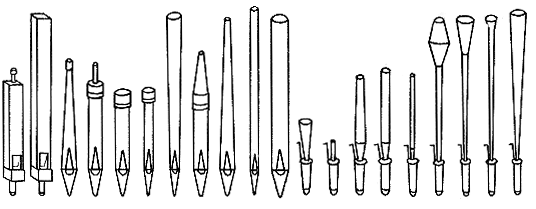
There are 6853 pipes 154 stopknobs and 106 ranks (complete sets of pipes) in the organ. If the pipes were laid out end to end, they would reach about 4 miles, or the distance from AUD to Webster Square.
The tallest pipe is 32 feet long, resulting in a very low pitch of 16 Hertz (cycles per second). Only high-end stereo speakers can produce low frequencies much below 50 Hz. Some of the taller pipes are higher than the chamber ceilings allow, and are “mitered” (segments cut at an angle to “bend” the pipe to make an elbow or U-turn in the top of the pipe) in order to fit.
The shortest pipe’s speaking (resonating air column) length is less than 1/2 inch, with a pitch higher than some people can hear (and higher than all but the best hi-fi speakers can produce) – over 16KHz.
There are three “floors” in each of the chambers behind the right and left grilles. The grille work is intentionally designed for maximum sound transmission (airflow opening) out into the Great Hall space.
The console is on an “elevator” so it can be hidden in the basement, at audience floor level, or at stage level. The elevator is not currently operational. The “orchestra pit” is on a separate elevator, which is currently stuck a few inches offset from the main floor level.
There are 2 percussion instruments (harp, chimes) within the organ playable from the keyboards and pedals.
The organ pipes and chests weigh more than 50 tons, equivalent to the weight of eight full-grown elephants.
Organ pipes are made out of wood or metal. For the metal pipes, special alloy (tin, lead, zinc) ratios are chosen for each rank in order to produce an optimal timbre (tone). When the seasons (temperature and humidity) change, the pipes can go out of tune with each other. Tuning is accomplished by adjusting the length of the pipe (for flue pipes) or the length of the vibrating reed (for reed/brass-instrument pipes). Remarkably, our Kimball has maintained its pitch incredibly close to its original A-440 (Hz) tuning.
Before the Industrial Revolution, pipe organs were the most complex large machines invented . (Clocks were complex small machines.)
Because the organist plays with two hands AND two feet, organ music scores typically have a separate bass clef just for the notes played by the feet. Organists wear special shoes with thin soles and thick (~1″ high) heels to allow agility in playing complex passages on the pedalboard. Up to 4- or 5-note chords are possible (using the heels AND toes of both feet, angled).
Organ benches must be adjustable to the organist’s leg length. Sometimes blocks of wood (or hymnals!) are placed under the bench sides to raise it up.
The pipe chest action (valve mechanism under each pipe) is electro-pneumatic. Over 100 miles of wiring is used in the organ, enough to reach from Worcester to New Haven. In an old and/or dirty (dusty) instrument, sometimes “things go wrong” – such as leaks in the wind supply system (hiss!, roar!), or ciphers (stuck notes due to a mechanical or electrical problem).
Sometimes major instrument components fail. In the 1957 concert played by Virgil Fox (internationally acclaimed performer of the period), the DC generator (power supply) failed, and the organ went silent in the middle of the concert. [ref: T&G article]
The organ chambers on each side are almost 40 feet tall – large enough to hold more than 50 minivans.
The console has:
- 276 keys (244 for the hands and 32 for the feet);
- 154 stop knobs;
- 32 tilting coupler tablets;
- 90 pistons (64 activated by the hands, 26 activated by the feet);
- 5 expression pedals to regulate the volume of the organ;
- 16 additional control buttons, plus organ blower and console light switches.
- With all the stops & couplers on, the pressing of a single key could activate 300+ pipes.
A 30-horsepower blower (air pump) supplies wind to the instrument – its electric motor is 3-phase (208 volts, 78 amps) and fills a room in the basement. It has three air pressure outputs: 8″, 10″, 20″
The organ was installed in 1933 and except for tuning and some re-leathering, has never been altered. It sounds just the way it did to audiences listening during the Great Depression.
It is the 7119th organ built by the Kimball Organ Company, out of over 7,300 organs built by this company. Each organ is numbered by Kimball and keeps its “opus” number (serial number) forever. We were near the end: only 210 more pipe organs were built by Kimball after AUD.
This was the last organ in the USA to be designated a “municipal organ.”
The AUD Kimball is the second largest instrument in Worcester County (the largest being at All Saints Church, installed also in 1933). Worcester is known as the “Pipe Organ Capital of New England” because it has so many very fine instruments.
The instrument originally cost $50,000, but in today’s dollars would cost over $10M. It needs several million dollars in restoration work to bring it back to full playing capacity.
ADDITIONAL PIPE ORGAN RESOURCES/EDUCATIONAL
- How Pipes Organs Work – demo handout (2 pages PDF)
- Young Person’s Guide – Fun illustrated descriptions (PDF)
